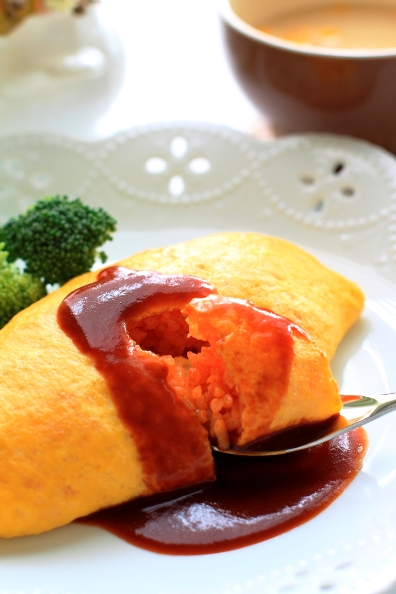2014 began with our family hosting a Japanese college student for a brief homestay. A Facebook friend of mine had a daughter studying in the United States; she had some time on her hands over the Christmas break, and she decided to spend some of it with us. Despite the arctic cold front that hit the area and talk of, “polar vortexes,” moving through the area, we toured around some of the monuments and museums of Washington DC that week, and also visited the beautiful aquarium in Baltimore and George Washington’s estate Mount Vernon in northern Virginia.
During Hiyori’s visit we ate a mish-mash of Asian and European food. On a couple of mornings I made a nice Japanese breakfast with homemade miso soup, rice, natto, baked fish, and some other small dishes which she loved and ate heartily. There were also some good steaks, some kimchi chigae, and my husband bought her a hot dog from a street-cart outside the Smithsonian on a cold afternoon.

For those of you unfamiliar with rice omelets, they are simply omelets stuffed with rice and flavored with ketchup. The rice is often leftover from other meals, and a variety of other fillings can accompany it, such as vegetables (especially onions, carrots and peas), chicken or pork, or fruits, like tomatoes and mushrooms. They are a mainstay of Japanese homecooking as well as a menu staple in casual restaurants and diners. Variations include using tonkatsu sauce or demi-glace in the place of ketchup for a slightly more high-brow taste.
For a dish so simple and unassuming, it is steeped in history. Rice omelets first started to be made in Japan around the turn of the 20th Century, but are part of a much larger trend of the introduction and adaptation of western dishes to Japanese tastes that began during the Meiji Restoration in the late 1860s. At the beginning of this period, Japan’s national seclusion was eliminated, and the Emperor declared Western ideas central to Japan’s future progress. As part of the reformations, the Emperor lifted the ban on red meat and promoted Western cuisine, which was viewed as the cause of the Westerner’s greater physical size.
The first curry recipes, which entered Japan via English sailors, appear in 1872, which within a decade proved so popular that they were on the menu at several Tokyo restaurants. Katsu, beefsteak and Hayashi rice are other examples of western dishes that were introduced during this period that have since gone on to be known as a subset of Japanese cuisine known as yōshoku (洋食) or western food.
To us, it was fascinating to discover that the one dish our Japanese guest wanted above all others was an omelet. How very western, we thought. But that’s just it, because it turns out that these omelets have become so integrated into modern Japanese food culture that they are as Japanese are cherry blossoms. So on to the basic recipe.
_____
Japanese Rice Omelet
Ingredients (for 1 omelet)
1 onion, minced
2-3 tablespoons oil
1½ cup precooked Japanese rice
1 cup of ketchup
2 eggs, whisked until frothy
Salt and pepper to taste
Directions
Oil a medium sauté pan with 2 tablespoons of oil and sauté the onion over medium heat until it becomes translucent and starts to color. Then add rice and the ketchup and stir well. Allow mixture to cook for a few minutes and then remove from the pan and set aside.
In a cleaned or fresh pan, add the remaining tablespoon of oil. Pour in frothed eggs, cook over low-to-medium heat until the bottom is firm and only a little bit of moisture is left on the top. Take care not to burn the bottom of the omelet.
Place the onion and rice mixture on a line down the center of the eggs, leaving at least ½ inch from both edges. Mound the mixture as best as you can and fold the edges of the omelet over the filling. Slide the omelet out onto a plate. Garnish with extra ketchup and serve leftover filling as a side dish. Often served with cucumbers or pickles and shredded cabbage dishes.
N.B. If you have a seasoned omelet pan, use it. You will need less oil if you do.
Variations: As noted above, additional ingredients can be included. These are added after the onion cooks and before the rice and ketchup are added.
_____
One of the nice surprises about rice omelets, besides the fact that they are very easy to make, is that all that ketchup is not as “ketchupy” as you might think. Somehow all that Heinz 57 cooks down a bit to taste more like a semi-sweet tomato sauce. Also, if folding omelets is something you find challenging, acceptable modern presentation of the dish in Japan include lightly-set eggs set onto the top of rice mounded on a plate. No folding and breaking, or filling falling out with that method. Not quite an omelet, perhaps, but the taste of the egg-topped rice is virtually the same.
So much a part of Japanese food culture, the rice omelet was featured in the 1985 movie, Tampopo. In the movie, a hobo father breaks into a kitchen after hours to cook a rice omelet for his son. Your Korean and Taiwanese friends might also recognize this dish as part of their cuisines. This is true, but it was introduced by the Japanese in the early 20th Century, so that the roots of the recipe may have been forgotten.
Fancy or plain, the modern Japanese (or Korean or Taiwanese) rice omelet is a result of west-east cultural connections that enriched both groups. The Japanese have made it a quintessential Japanese dish, and westerners are rediscovering it and making it their own once again. (Words by Laura Kelley; Photo of Japanese Rice Omelet from iStock; and video excerpt from Tampopo from You Tube.)
